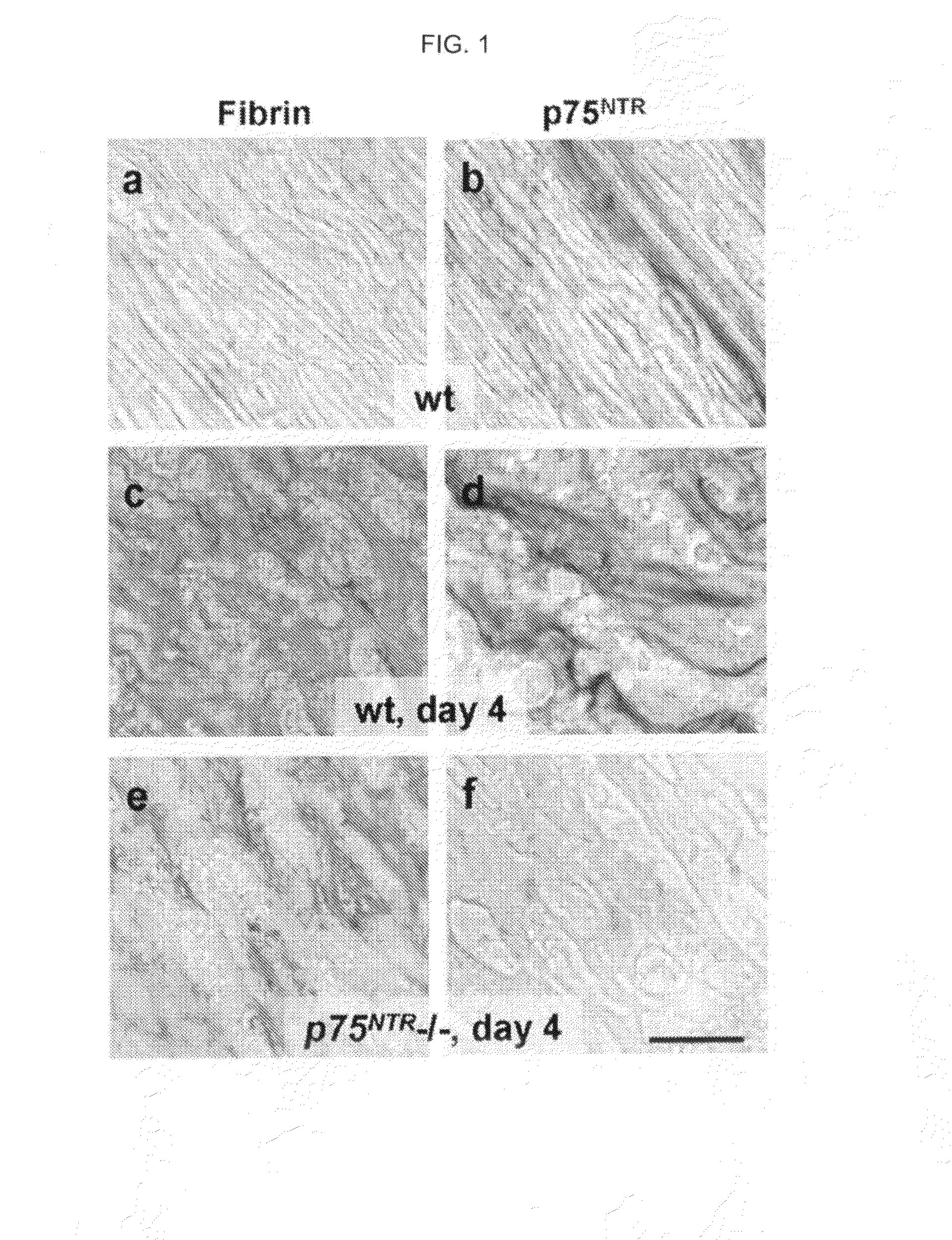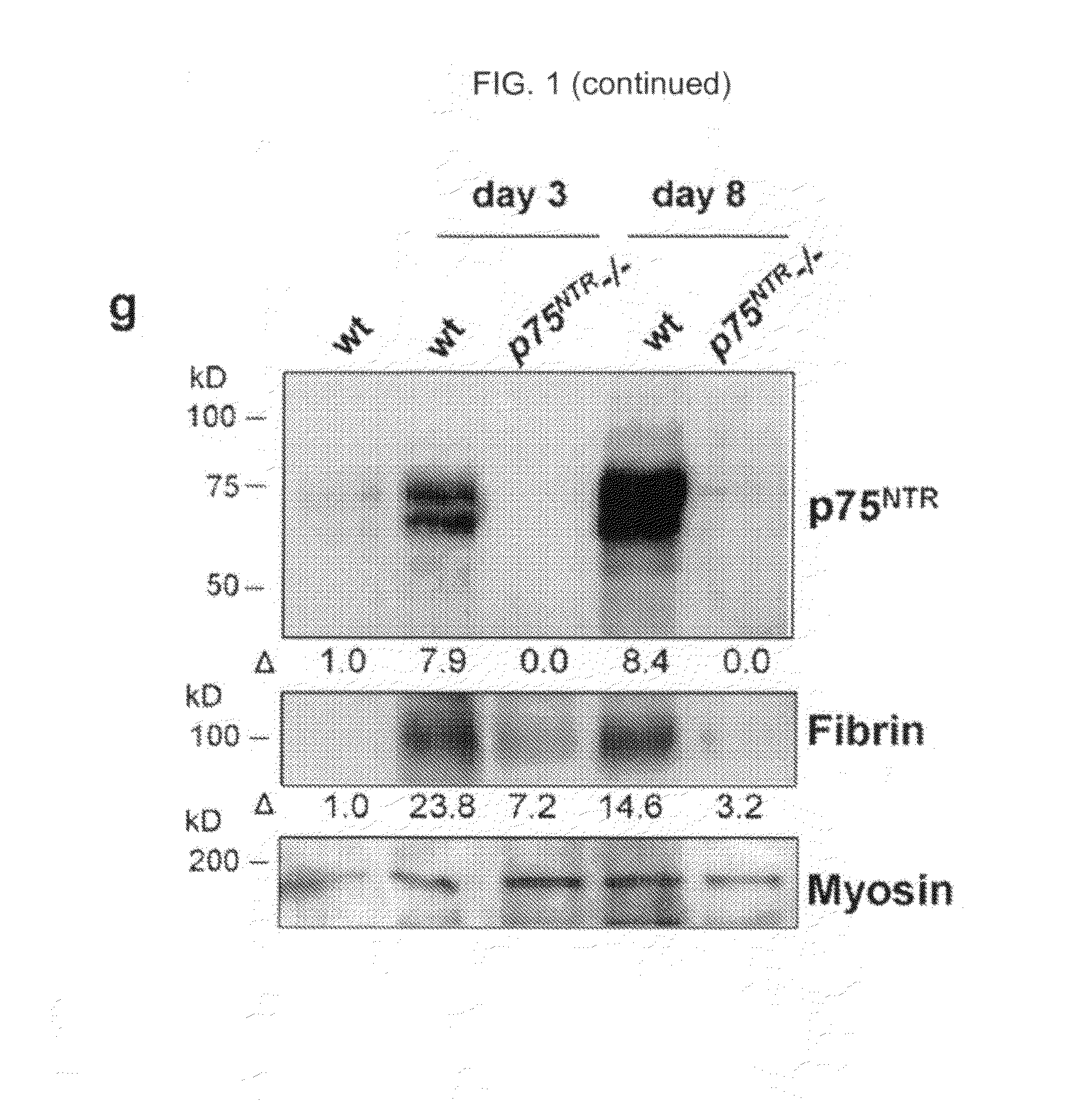Inhibitors of PDE4 and Methods of Use
a technology of pde4 and inhibitors, applied in the field of specific drugs, can solve the problems of limiting factors for tissue repair, unclear molecular mechanisms that the nervous system utilizes to regulate proteolytic activity, and variable side effects
- Summary
- Abstract
- Description
- Claims
- Application Information
AI Technical Summary
Benefits of technology
Problems solved by technology
Method used
Image
Examples
example 1
Fibrin Deposition is Reduced in p75NTR− / − Mice
[0114]To examine whether p75NTR regulates fibrin deposition in the sciatic nerve fibrin levels in wild-type (wt) and p75NTR− / − mice were compared after injury. FIG. 1 depicts immunohistochemistry for fibrin on uninjured wt (a) and 4 d after sciatic nerve crush injury wt (c) and p75NTR− / − mice (e). Immunohistochemistry for p75NTR on uninjured wt (b) and 4 d after sciatic nerve crush injury wt (d) and p75NTR− / − mice (f). Representative images are shown from n=20 wt and n=20 p75NTR− / − mice. (g) Western blot for p75NTR and fibrin on sciatic nerve extracts from uninjured wt, and wt and p75NTR− / − mice 3 and 8 d after injury. Myosin serves as loading control. Western blots were performed three times. A representative blot is shown. (h) Quantification of fibrin deposition shows significant decrease for fibrin in p75NTR− / − mice (n=5), when compared with wt mice (n=4). Bar graph represents means±SEM (P<0.003; by t test). Bar, 25 μm.
[0115]In wt mic...
example 2
p75NTR Regulates Expression of tPA in the Sciatic Nerve after Crush Injury
[0116]Analysis of total fibrinogen levels were similar in the plasma of wt and p75NTR− / − mice (unpublished data), suggesting the decrease in fibrin deposition is not the result of hypofibrinogenemia. FIG. 2 depicts in situ zymography in the presence of plasminogen on wt (a) and p75NTR− / − (b) mice and in the absence of plasminogen (c) or in the presence of plasminogen and tPASTOP (d) in p75NTR− / − mice. Arrows indicate the lytic zone. Double immunofluorescence for tPA (green) or p75NTR (red) on wt (e and h), p75NTR− / − (f) and p75NTR− / −tPA− / − mice (g). Uninjured wt sciatic nerve exhibits minimal proteolytic activity (i) and minimal tPA and p75NTR immunoreactivity (j). Zymographies have been performed on n=10 wt and n=10 p75NTR− / − mice. Representative images are shown. tPA (k) and p75NTR (l) expression in SCs was verified by double immunofluorescence with an S100 (SC marker) antibody. Arrows indicate double-positi...
example 3
Genetic Loss of tPA Rescues the Effects of p75NTR Deficiency
[0118]To examine genetically whether the increased proteolytic activity in the p75NTR− / − mice was due to tPA, we crossed p75NTR− / − mice with tPA− / − mice and generated p75NTR− / −tPA− / − doubleknockout mice. FIG. 9 depicts increased fibrin deposition in the crushed sciatic nerve of p75NTR−−tPA− / − mice (c), when compared with crushed p75NTR− / − sciatic nerve (b). Wt (a) and tPA− / − (d) nerves are used for control. In situ zymography shows lack of proteolytic activity in the crushed p75NTR− / −tPA− / − sciatic nerves (n=5) (g), when compared with crushed p75NTR− / − sciatic nerves (n=20) (f). Crushed wt (e) and tPA− / − (h) nerves are used for control. Fibrin immunostainings and zymographies were performed on n=5 p75NTR−−tPA− / −, n=20 p75NTR− / −, n=20 wt, n=5 tPA− / − mice. Representative images are shown. (i) Quantification of proteolytic activity 4 d after crush injury shows statistically significant increase for proteolytic activity in p75N...
PUM
| Property | Measurement | Unit |
|---|---|---|
| Fraction | aaaaa | aaaaa |
Abstract
Description
Claims
Application Information
 Login to View More
Login to View More - R&D
- Intellectual Property
- Life Sciences
- Materials
- Tech Scout
- Unparalleled Data Quality
- Higher Quality Content
- 60% Fewer Hallucinations
Browse by: Latest US Patents, China's latest patents, Technical Efficacy Thesaurus, Application Domain, Technology Topic, Popular Technical Reports.
© 2025 PatSnap. All rights reserved.Legal|Privacy policy|Modern Slavery Act Transparency Statement|Sitemap|About US| Contact US: help@patsnap.com



